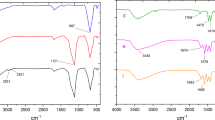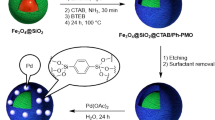Abstract
Developing artificial nanomaterial systems that can convert external stimuli to achieve nanoscale self-sustainable motion (for example, self-rotation), and simultaneously integrate and deploy the spatial localization of multiple active sites to unravel the intraparticle diffusion patterns of molecules, is of great importance for green synthetic chemistry. Here we show a paddle-like self-stirring mesoporous silica nanoreactor system with separated chambers and controllable proximity of active sites. The nanoreactors are designed by encapsulating magnetic Fe3O4 (~20 nm) in the first chamber, and meantime, Au and Pd nanocrystals are spatially isolated in different domains. Such a nanoreactor generates nanoscale rotation under the rotating magnetic fields and exhibits an order of magnitude activity enhancement in the cascade synthesis of 5,6-dimethylphenanthridinium (96.4% selectivity) compared with conventional macro-stirring. Meanwhile, we quantitatively uncovered the rotation-induced enhancement in sequential and reverse transfer of reactive intermediates, consequently revealing the relevance of self-rotation and proximity effects in controlling the catalytic performance.
This is a preview of subscription content, access via your institution
Access options
Access Nature and 54 other Nature Portfolio journals
Get Nature+, our best-value online-access subscription
$32.99 / 30 days
cancel any time
Subscribe to this journal
Receive 12 print issues and online access
$259.00 per year
only $21.58 per issue
Buy this article
- Purchase on SpringerLink
- Instant access to full article PDF
Prices may be subject to local taxes which are calculated during checkout






Similar content being viewed by others
Data availability
Data supporting the findings of this study are available within the article and the associated Supplementary Information section. Source data are provided with this paper.
References
Fogg, D. E. & dos Santos, E. N. Tandem catalysis: a taxonomy and illustrative review. Coord. Chem. Rev. 248, 2365–2379 (2004).
Zhang, F. et al. Polyethylene upcycling to long-chain alkylaromatics by tandem hydrogenolysis/aromatization. Science 370, 437–441 (2020).
Yan, H. et al. Tandem In2O3-Pt/Al2O3 catalyst for coupling of propane dehydrogenation to selective H2 combustion. Science 371, 1257–1260 (2021).
Monai, M. et al. Propane to olefins tandem catalysis: a selective route towards light olefins production. Chem. Soc. Rev. 50, 11503–11529 (2021).
Zhang, M. et al. Pickering emulsion droplets and solid microspheres acting synergistically for continuous-flow cascade reactions. Nat. Catal. 7, 295–306 (2024).
Zou, H. et al. Dual metal nanoparticles within multicompartmentalized mesoporous organosilicas for efficient sequential hydrogenation. Nat. Commun. 12, 4968 (2021).
Li, Y. et al. Distance for communication between metal and acid sites for syngas conversion. ACS Catal. 12, 8793–8801 (2022).
Ma, Y. et al. Remodeling nanodroplets into hierarchical mesoporous silica nanoreactors with multiple chambers. Nat. Commun. 13, 6136 (2022).
Pei, C. & Gong, J. Tandem catalysis at nanoscale. Science 371, 1203–1204 (2021).
Lim, K. R. G. et al. Nanoparticle proximity controls selectivity in benzaldehyde hydrogenation. Nat. Catal. 7, 172–184 (2024).
Nivina, A. et al. Evolution and diversity of assembly-line polyketide synthases. Chem. Rev. 119, 12524–12547 (2019).
Shklyaev, O. E. & Balazs, A. C. Interlinking spatial dimensions and kinetic processes in dissipative materials to create synthetic systems with lifelike functionality. Nat. Nanotechnol. 19, 146–159 (2024).
Wu, X. & Xu, D. Formation of yolk/SiO2 shell structures using surfactant mixtures as template. J. Am. Chem. Soc. 131, 2774–2775 (2009).
Teng, Z. et al. A facile multi-interface transformation approach to monodisperse multiple-shelled periodic mesoporous organosilica hollow spheres. J. Am. Chem. Soc. 137, 7935–7944 (2015).
Marguet, M., Bonduelle, C. & Lecommandoux, S. Multicompartmentalized polymeric systems: towards biomimetic cellular structure and function. Chem. Soc. Rev. 42, 512–529 (2013).
Schoonen, L. & van Hest, J. C. M. Compartmentalization approaches in soft matter science: from nanoreactor development to organelle mimics. Adv. Mater. 28, 1109–1128 (2016).
Suteewong, T. et al. Multicompartment mesoporous silica nanoparticles with branched shapes: an epitaxial growth mechanism. Science 340, 337–341 (2013).
Han, F. et al. On demand synthesis of hollow fullerene nanostructures. Nat. Commun. 10, 1548 (2019).
Han, F. et al. Precise dimerization of hollow fullerene compartments. J. Am. Chem. Soc. 142, 15396–15402 (2020).
Ma, Y. et al. Synthesis of branched silica nanotrees using a nanodroplet sequential fusion strategy. Nat. Synth. 3, 236–244 (2024).
Yu, Z. et al. Ruthenium-nanoparticle-loaded hollow carbon spheres as nanoreactors for hydrogenation of levulinic acid: explicitly recognizing the void-confinement effect. Angew. Chem. Int. Ed. 60, 20786–20794 (2021).
Wei, Y. et al. A universal formation mechanism of hollow multi-shelled structures dominated by concentration waves. Angew. Chem. Int. Ed. 62, e202302621 (2023).
Peters, R. J. R. W. et al. Cascade reactions in multicompartmentalized polymersomes. Angew. Chem. Int. Ed. 126, 150–154 (2014).
Chong, W. et al. Stirring in suspension: nanometer-sized magnetic stir bars. Angew. Chem. Int. Ed. 125, 8732–8735 (2013).
Yang, S. et al. Nanoscale magnetic stirring bars for heterogeneous catalysis in microscopic systems. Angew. Chem. Int. Ed. 127, 2699–2702 (2015).
Zhou, X. et al. Enhancing reaction rate in a Pickering emulsion system with natural magnetotactic bacteria as nanoscale magnetic stirring bars. Chem. Sci. 9, 2575–2580 (2018).
Wang, H. et al. Unconventional chain-growth mode in the assembly of colloidal gold nanoparticles. Angew. Chem. Int. Ed. 51, 8021–8025 (2012).
Yang, Y. et al. Spindle-shaped nanoscale yolk/shell magnetic stirring bars for heterogeneous catalysis in macro- and microscopic systems. Chem. Commun. 52, 1575–1578 (2016).
Zhang, T. et al. Co@C nanorods as both magnetic stirring nanobars and magnetic recyclable nanocatalysts for microcatalytic reactions. Appl. Catal. B 304, 120925 (2022).
Ji, Q. et al. Scalable and continuous preparation of nano-stirbars by electrospinning. Chem. Commun. 56, 11767–11770 (2020).
Aubert, T. et al. Two-dimensional superstructures of silica cages. Adv. Mater. 32, 1908362 (2020).
Zhang, T. et al. Synthesis of podlike magnetic mesoporous silica nanochains for use as enzyme support and nanostirrer in biocatalysis. ACS Appl. Mater. Interfaces 12, 17901–17908 (2020).
Wan, L. et al. A magnetic-field guided interface coassembly approach to magnetic mesoporous silica nanochains for osteoclast-targeted inhibition and heterogeneous nanocatalysis. Adv. Mater. 30, 1707515 (2018).
Ebensperger, P. et al. A dual-metal-catalyzed sequential cascade reaction in an engineered protein cage. Angew. Chem. Int. Ed. 62, e202218413 (2023).
Ma, Y. et al. Streamlined mesoporous silica nanoparticles with tunable curvature from interfacial dynamic-migration strategy for nanomotors. Nano Lett. 21, 6071–6079 (2021).
Acknowledgements
This work was supported by the National Key R&D Program of China (2018YFA0209401) (D.Z.), the National Natural Science Foundation of China (22088101 (D.Z.), 21733003 (D.Z.), 51961145403 (D.Z.) and 22375107 (Y.M.)), the Key Basic Research Program of Science and Technology Commission of Shanghai Municipality (22JC1410200) (D.Z.) and the National Natural Science Foundation of China (62227815) (J.L.). This publication was made possible by the Inner Mongolia Natural Science Foundation Youth Fund (2023QN02013) (Y.M.) and the Young Science and Technology Talent Program (NJYT24068) (Y.M.). The statements made herein are solely the responsibility of the authors. We wish to thank Q. He and the Electron Microscopy Centre of Inner Mongolia University for the microscopy and microanalysis of our specimens.
Author information
Authors and Affiliations
Contributions
D.Z. and Y.M. contributed to the conception and writing of the paper. J. Liu, Z.L. and H.Z. helped edit and discuss the paper. Y.M. and P.G. performed all material syntheses, characterizations, data collection and analysis. J. Li, A.W., B.M., J.J., Y.A. and W.Z. assisted P.G. for the synthesis of materials and the data collection and analysis. S.G., X.P., Z.L. and Y.-L.Z. performed the simulation of the rotation of nanoreactors. J. Li, X.L. and L.D. involved in partial nano-stirring paddle data and analysis. H.Z. helped conduct catalytic experiments and data analysis. Y.M., P.G. and B.M. contributed equally to this work. All authors read and commented on the paper.
Corresponding authors
Ethics declarations
Competing interests
The authors declare no competing interests.
Peer review
Peer review information
Nature Nanotechnology thanks Jun Chen, Yusuke Yamauchi and the other, anonymous, reviewer(s) for their contribution to the peer review of this work.
Additional information
Publisher’s note Springer Nature remains neutral with regard to jurisdictional claims in published maps and institutional affiliations.
Supplementary information
Supplementary Information
Table of contents, Supplementary methods, Figs. 1–50 and Tables 1 and 2.
Supplementary Video 1
Concept video of planetary cascade nanoreactors.
Supplementary Video 2
Parallel stirring of nanopaddle-containing droplets.
Supplementary Video 3
The motion trajectories of nano-stirring paddles.
Supplementary Video 4
Planetary group patterns of the nano-stirring paddles with different concentrations.
Supplementary Video 5
Simulation of the effect of rotation on molecular mixing.
Supplementary Video 6
Degradation of MB under nano-stirring.
Supplementary Video 7
The stirring of solution by nano-stirring paddle.
Supplementary Video 8
The influence of macro-stirring on intermediate diffusion.
Supplementary Video 9
The influence of nano-stirring (nanoreactor 1) on intermediate diffusion.
Supplementary Video 10
Diffusion paths of intermediates between two adjacent nanoreactors.
Supplementary Video 11
The influence of nano-stirring (nanoreactor 2) on intermediate diffusion.
Supplementary Video 12
The influence of nano-stirring (nanoreactor 3) on intermediate diffusion.
Supplementary Data
Source data for supplementary figures.
Source data
Source Data Fig. 2
Statistical source data Fig. 2f.
Source Data Fig. 3
Statistical source data Fig. 3a,b,d–g.
Source Data Fig. 4
Statistical source data Fig. 4d–f,h–j.
Source Data Fig. 5
Statistical source data Fig. 5c–e.
Source Data Fig. 6
Statistical source data Fig. 6c,d,f,j.
Rights and permissions
Springer Nature or its licensor (e.g. a society or other partner) holds exclusive rights to this article under a publishing agreement with the author(s) or other rightsholder(s); author self-archiving of the accepted manuscript version of this article is solely governed by the terms of such publishing agreement and applicable law.
About this article
Cite this article
Ma, Y., Guo, P., Ma, B. et al. Paddle-like self-stirring nanoreactors with multi-chambered mesoporous branches for enhanced dual-dynamic cascade reactions. Nat. Nanotechnol. 20, 897–906 (2025). https://doi.org/10.1038/s41565-025-01915-2
Received:
Accepted:
Published:
Issue date:
DOI: https://doi.org/10.1038/s41565-025-01915-2
This article is cited by
-
A magnetically programmable mesoporous nanoreactor
Nature Nanotechnology (2025)



